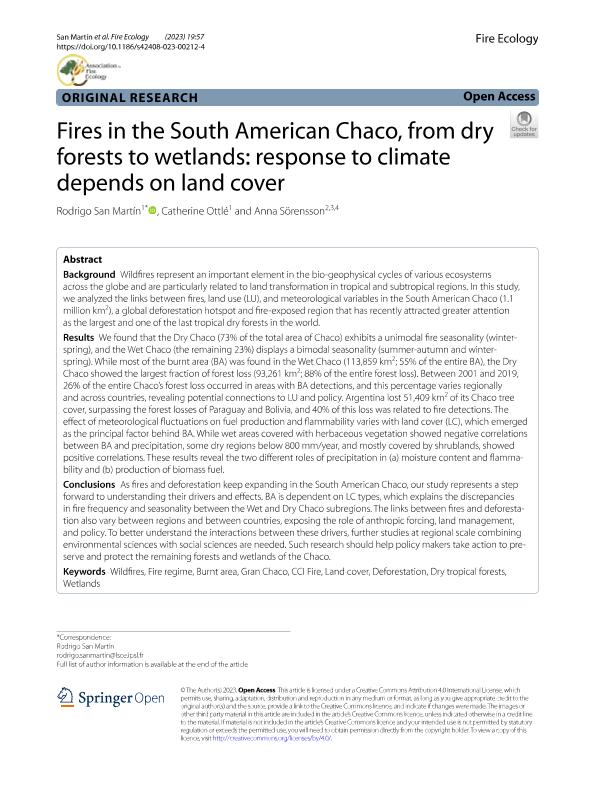Mostrar el registro sencillo del ítem
dc.contributor.author
San Martín, Rodrigo
dc.contributor.author
Ottlé, Catherine
dc.contributor.author
Sörensson, Anna

dc.date.available
2024-01-25T12:47:55Z
dc.date.issued
2023-12
dc.identifier.citation
San Martín, Rodrigo; Ottlé, Catherine; Sörensson, Anna; Fires in the South American Chaco, from dry forests to wetlands: response to climate depends on land cover; Springer; Fire Ecology; 19; 1; 12-2023; 1-20
dc.identifier.issn
1933-9747
dc.identifier.uri
http://hdl.handle.net/11336/224784
dc.description.abstract
Background: Wildfires represent an important element in the bio-geophysical cycles of various ecosystems across the globe and are particularly related to land transformation in tropical and subtropical regions. In this study, we analyzed the links between fires, land use (LU), and meteorological variables in the South American Chaco (1.1 million km2), a global deforestation hotspot and fire-exposed region that has recently attracted greater attention as the largest and one of the last tropical dry forests in the world. Results: We found that the Dry Chaco (73% of the total area of Chaco) exhibits a unimodal fire seasonality (winter-spring), and the Wet Chaco (the remaining 23%) displays a bimodal seasonality (summer-autumn and winter-spring). While most of the burnt area (BA) was found in the Wet Chaco (113,859 km2; 55% of the entire BA), the Dry Chaco showed the largest fraction of forest loss (93,261 km2; 88% of the entire forest loss). Between 2001 and 2019, 26% of the entire Chaco’s forest loss occurred in areas with BA detections, and this percentage varies regionally and across countries, revealing potential connections to LU and policy. Argentina lost 51,409 km2 of its Chaco tree cover, surpassing the forest losses of Paraguay and Bolivia, and 40% of this loss was related to fire detections. The effect of meteorological fluctuations on fuel production and flammability varies with land cover (LC), which emerged as the principal factor behind BA. While wet areas covered with herbaceous vegetation showed negative correlations between BA and precipitation, some dry regions below 800 mm/year, and mostly covered by shrublands, showed positive correlations. These results reveal the two different roles of precipitation in (a) moisture content and flammability and (b) production of biomass fuel. Conclusions: As fires and deforestation keep expanding in the South American Chaco, our study represents a step forward to understanding their drivers and effects. BA is dependent on LC types, which explains the discrepancies in fire frequency and seasonality between the Wet and Dry Chaco subregions. The links between fires and deforestation also vary between regions and between countries, exposing the role of anthropic forcing, land management, and policy. To better understand the interactions between these drivers, further studies at regional scale combining environmental sciences with social sciences are needed. Such research should help policy makers take action to preserve and protect the remaining forests and wetlands of the Chaco.
dc.format
application/pdf
dc.language.iso
eng
dc.publisher
Springer

dc.rights
info:eu-repo/semantics/openAccess
dc.rights.uri
https://creativecommons.org/licenses/by/2.5/ar/
dc.subject
BURNT AREA
dc.subject
CCI FIRE
dc.subject
DEFORESTATION
dc.subject
DRY TROPICAL FORESTS
dc.subject
FIRE REGIME
dc.subject
GRAN CHACO
dc.subject
LAND COVER
dc.subject
WETLANDS
dc.subject
WILDFIRES
dc.subject.classification
Ciencias Medioambientales

dc.subject.classification
Ciencias de la Tierra y relacionadas con el Medio Ambiente

dc.subject.classification
CIENCIAS NATURALES Y EXACTAS

dc.title
Fires in the South American Chaco, from dry forests to wetlands: response to climate depends on land cover
dc.type
info:eu-repo/semantics/article
dc.type
info:ar-repo/semantics/artículo
dc.type
info:eu-repo/semantics/publishedVersion
dc.date.updated
2024-01-23T11:31:08Z
dc.journal.volume
19
dc.journal.number
1
dc.journal.pagination
1-20
dc.journal.pais
Alemania

dc.description.fil
Fil: San Martín, Rodrigo. Centre National de la Recherche Scientifique; Francia
dc.description.fil
Fil: Ottlé, Catherine. Centre National de la Recherche Scientifique; Francia
dc.description.fil
Fil: Sörensson, Anna. Universidad de Buenos Aires. Facultad de Ciencias Exactas y Naturales. Centro de Investigaciones del Mar y la Atmósfera; Argentina. Consejo Nacional de Investigaciones Científicas y Técnicas. Oficina de Coordinación Administrativa Ciudad Universitaria. Centro de Investigaciones del Mar y la Atmósfera. Universidad de Buenos Aires. Facultad de Ciencias Exactas y Naturales. Centro de Investigaciones del Mar y la Atmósfera; Argentina
dc.journal.title
Fire Ecology
dc.relation.alternativeid
info:eu-repo/semantics/altIdentifier/doi/http://dx.doi.org/10.1186/s42408-023-00212-4
Archivos asociados
